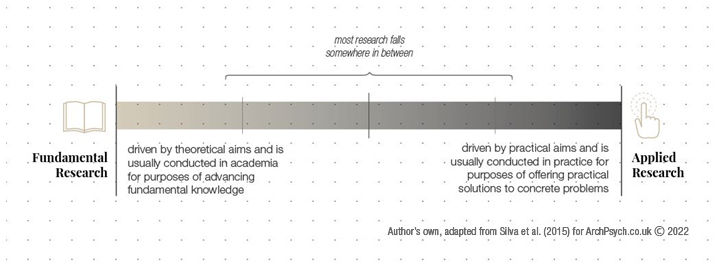Research in Context: The Fundamental-Applied Continuum.
- Archontia Manolakelli

- Jun 25, 2022
- 3 min read
Updated: Jul 4, 2023
In previous articles, the interface between academia and practice has been mentioned as Environmental Psychology is discussed in each context respectively. This brief article aims to define two terms that are often used to describe research that is conducted for different purposes in relation to this.

Photo by Vlada Karpovich via Pexels
The definitions below originate from ‘The Routledge Handbook of Planning Research Methods’ (Silva et al., 2015, p. 62):
Fundamental (or basic) research refers to research that “is driven by theoretical aims and is conducted in academia for purposes of advancing fundamental knowledge about planning and the world that planning deals with. An example would be a survey at a housing project to test a theoretical model of residential satisfaction.”
Applied research on the other hand is “is driven by practical aims and is conducted in practice for purposes of offering practical solutions to concrete problems. An example would be a post-occupancy evaluation that informs authorities how residents are experiencing a housing project.”

Although either type of research can be conducted both within academia and in practice, academic research typically tends towards the fundamental end of the spectrum, and practice-based research towards the applied. However, as Silva et al. mention, “basic and applied research represent two ends of a continuum with no clear distinction between them” (2015, p. 63) and as a result, it is rare to find research that is purely one or the other.
As for many other fields that span across academia and practice, both fundamental and applied research are crucial parts of Environmental Psychology. The fundamental research answers questions of why social phenomena occur, how they can be categorised, whether findings can be generalised etc. without aiming for a specific application, whereas applied research looks into evaluating or understanding what can be done to alter circumstances towards a specific direction or outcome by evaluating a solution, planning an intervention or encouraging participation (Du Toit & Mouton, 2013). As such, there is a natural dialogue between fundamental and applied research with one leading to questions and research opportunities for the other.
Implications for Architecture.
Selecting the right type of research depending on the context is really important for the suitability of outcomes. For example, as Architects we are often part of the “applied” research audience, looking for practical solutions and guidance for specific challenges. Therefore approaches we are most familiar with may include interviews, focus groups, workshops, and participatory or action research, which are often used to derive key insights from clients during the briefing process, or engage with stakeholders and the wider community to identify a preferred way forward. Survey studies, modelling and simulation may also be used to collect data during processes such as post-occupancy evaluation (POE), that require more quantitative approaches (Du Toit & Mouton, 2013).
That said, it does not mean that findings from fundamental research are irrelevant, as they are often used to derive crucial insights that either drive applied research, or form direct guidance that can be used in practice with some level of interpretation. Desktop studies that take place during inception and design development stages to inform proposals often include insights from fundamental research. Similarly, the formation of design guidelines for various types of environments often relies on fundamental research to produce evidence-based suggestions for intervention towards specific outcomes.
Some closing thoughts.
As discussed in this short piece, there is no hard line between fundamental and applied research. This is something very important to remember in the context of large and complex challenges (e.g. climate change, overpopulation, resource depletion), that require a sophisticated set of insights to help decision-makers identify more suitable solutions. As Architects we should not be afraid to reach outside our comfort zone into methods and areas of research that are more suitable for the task at hand, especially if key information is unavailable or lacking. This could take various forms such as conducting fundamental research in practice, supporting more direct collaborations between practice and academia, developing expertise in mixed method approaches, implementing evidence-based design as an integral part of the design process etc.
Archontia Manolakelli is an Architect and interdisciplinary Design Researcher based in Manchester, UK. Her commitment to designing more comfortable, inclusive and sustainable places using an evidence-based approach, led her to discover Environmental Psychology back in 2016. Since then she has continued to further her knowledge on this wonderful field through the study of psychology and approach to professional practice in architecture.
Hello. Thank you for stopping by, I hope you have enjoyed your reading! If you have any questions or feedback on this article, please don't hesitate to drop me a line on LinkedIn or via email.
Citations.
Du Toit, J., & Mouton, J. (2013). A typology of designs for social research in the built environment. International Journal Of Social Research Methodology, 16(2), 125-139. https://doi.org/10.1080/13645579.2012.657013
Silva, E., Healey, P., Harris, N., & Van den Broeck, P. (2015). The Routledge Handbook of Planning Research Methods. Routledge.



